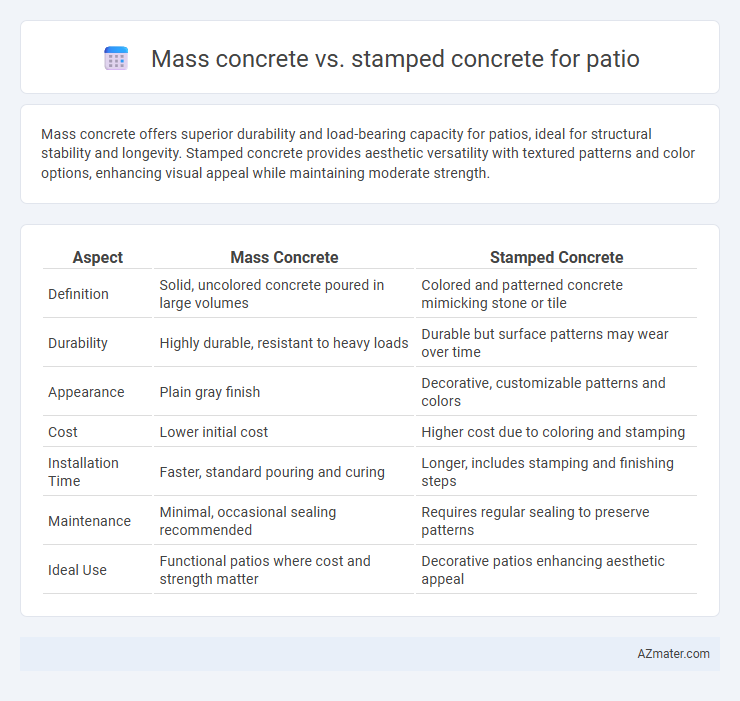Mass concrete offers superior durability and load-bearing capacity for patios, ideal for structural stability and longevity. Stamped concrete provides aesthetic versatility with textured patterns and color options, enhancing visual appeal while maintaining moderate strength.
Table of Comparison
| Aspect | Mass Concrete | Stamped Concrete |
|---|---|---|
| Definition | Solid, uncolored concrete poured in large volumes | Colored and patterned concrete mimicking stone or tile |
| Durability | Highly durable, resistant to heavy loads | Durable but surface patterns may wear over time |
| Appearance | Plain gray finish | Decorative, customizable patterns and colors |
| Cost | Lower initial cost | Higher cost due to coloring and stamping |
| Installation Time | Faster, standard pouring and curing | Longer, includes stamping and finishing steps |
| Maintenance | Minimal, occasional sealing recommended | Requires regular sealing to preserve patterns |
| Ideal Use | Functional patios where cost and strength matter | Decorative patios enhancing aesthetic appeal |
Understanding Mass Concrete and Stamped Concrete
Mass concrete is a solid, uniform mixture primarily used for structural purposes, known for its durability, strength, and ability to withstand heavy loads, making it ideal for foundational patio bases. Stamped concrete involves pressing molds or patterns into concrete before it fully sets, creating decorative surfaces that mimic materials like stone, brick, or slate, enhancing aesthetic appeal. Understanding the distinct functions of mass concrete's robustness versus stamped concrete's design versatility is crucial for selecting the right patio material based on structural needs and visual preferences.
Key Differences Between Mass Concrete and Stamped Concrete
Mass concrete for patios involves large, solid slabs of plain concrete primarily valued for its strength and durability, while stamped concrete features textured patterns that mimic materials like stone or brick, offering enhanced aesthetics. Mass concrete is typically more cost-effective and requires less maintenance, suitable for heavy-duty applications, whereas stamped concrete demands skilled installation and periodic sealing to preserve its decorative finish. The key differences lie in functionality--mass concrete prioritizes structural integrity, whereas stamped concrete combines durability with ornamental appeal.
Aesthetic Appeal: Mass Concrete vs Stamped Concrete Patios
Stamped concrete patios offer superior aesthetic appeal compared to mass concrete due to their ability to mimic natural stone, brick, or wood textures with intricate patterns and vibrant colors. Mass concrete patios typically lack decorative elements, resulting in a uniform, plain surface that prioritizes durability over design variety. The customization potential of stamped concrete enhances outdoor spaces, making it a popular choice for homeowners seeking both functionality and visual interest.
Durability and Longevity Comparison
Mass concrete offers superior durability for patios due to its dense composition and high compressive strength, making it highly resistant to cracking and weathering over time. Stamped concrete, while visually attractive with customizable patterns and textures, typically includes surface treatments that may wear down faster under heavy foot traffic and environmental exposure. For long-term patio installations, mass concrete ensures greater longevity with minimal maintenance compared to the more decorative but less durable stamped concrete.
Installation Process: Step-by-Step Overview
Mass concrete installation for patios involves pouring a large volume of concrete in a single pour, requiring careful temperature control and curing to prevent cracking or shrinkage. Stamped concrete installation includes pouring a base slab, applying color hardeners, and stamping patterns while the concrete is still pliable, with additional layers for sealing and protection. Both methods demand preparation of a stable sub-base, precise timing during setting, and post-installation maintenance to ensure durability and aesthetic appeal.
Maintenance Requirements for Mass vs Stamped Concrete
Mass concrete patios require minimal maintenance, typically involving occasional cleaning and sealing every few years to prevent cracking and weather damage. Stamped concrete demands more frequent upkeep, including regular sealing to preserve color, prevent surface wear, and reduce susceptibility to stains and cracks. Proper maintenance of stamped concrete ensures longevity and aesthetic appeal, while mass concrete offers durability with less intensive care.
Cost Analysis: Which Option is More Budget-Friendly?
Mass concrete patios typically cost between $4 to $8 per square foot, offering a budget-friendly option due to lower material and installation expenses. Stamped concrete ranges from $8 to $15 per square foot, reflecting higher costs driven by decorative patterns, color enhancements, and skilled labor requirements. For cost-conscious homeowners, mass concrete presents a more affordable solution while stamped concrete adds aesthetic value at a premium price.
Slip Resistance and Safety Considerations
Mass concrete patios offer superior slip resistance due to their rougher texture and natural aggregate exposure, reducing the risk of slips and falls in wet conditions. Stamped concrete, while visually appealing with intricate patterns, can become slippery when wet if not treated with anti-slip sealers or additives, requiring more maintenance for safety. Choosing slip-resistant sealers and regular surface treatments enhances safety for stamped concrete patios without sacrificing aesthetic appeal.
Environmental Impact of Each Concrete Type
Mass concrete for patios involves large volumes of Portland cement, resulting in higher carbon emissions due to cement production's energy-intensive processes and raw material extraction. Stamped concrete, while using similar base materials, often requires less volume and can incorporate recycled aggregates or supplementary cementitious materials, reducing its overall environmental footprint. Both types impact ecosystems differently, but stamped concrete offers more sustainable options through resource efficiency and potential reuse of materials.
Choosing the Best Option for Your Patio Project
Mass concrete offers superior structural strength and durability for patios requiring heavy load-bearing capacity, making it ideal for long-lasting foundational support. Stamped concrete provides aesthetic versatility with customizable patterns and textures that mimic natural materials while maintaining moderate durability. Evaluating factors such as budget, desired appearance, and project scale helps determine whether mass concrete's robustness or stamped concrete's decorative appeal is best suited for your patio project.

Infographic: Mass concrete vs Stamped concrete for Patio
 azmater.com
azmater.com